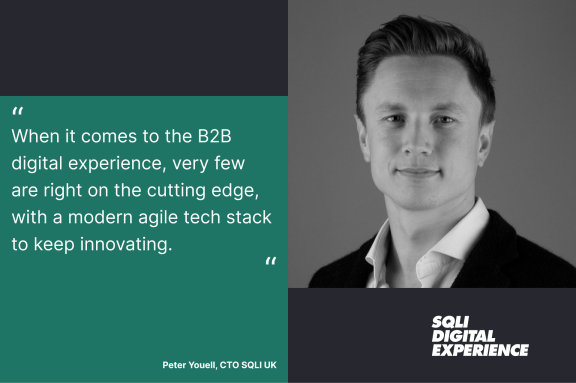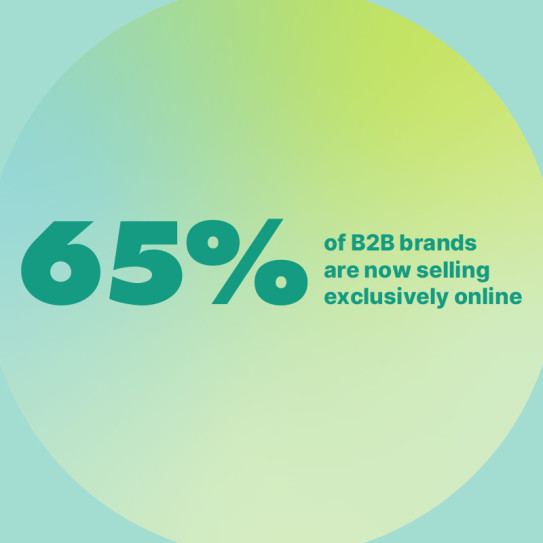
Why the time for B2B digital transformation is now!
Pete Youell, SQLI Group CTO, looks at common painpoints, trends and commerce systems as he shares his thoughts on the future of the digital B2B industry.
The travelling salesman; spreadsheets; old legacy platforms with buyers still needing an invoice to finalise the purchase. The image of the B2B industry has often been one of archaic processes and systems, especially when compared to its glamorous, shiny B2C counterpart.
The associated digital experiences are no different. Many online B2B merchants have been so focused on sales, they’ve not stepped back to look at their platforms, the customer experience and what this means for the future of their business.
While B2C digital stores have pushed the boundaries of creativity and technology over the past decade, in terms of architecture and omnichannel offerings with dynamic personalised experiences, the online B2B industry has in many ways, stood still.
B2B eCommerce: a growing market
However, times are changing. Today, 96 per cent of the B2B market has some sort of digital exposure, with nearly 65 per cent of B2B brands selling exclusively online.
The global B2B eCommerce market was estimated to be around $6.92trillion in 2021, but predicted to grow to $18.9trillion by 2028.
Meanwhile, buyers want to be able to compare products and prices easily online, expect to shop on multiple channels and want easy online transactions through frictionless checkouts, with sales no longer dependent on face-to-face meetings.
For digital experience experts SQLI, more B2B merchants than ever are turning to them for a re-platform or digital improvements – or in many cases looking for more strategic know-how.
And for Pete Youell, SQLI Group CTO, it’s an exciting time to be in the digital B2B sphere, with the buzz around the industry growing.
He said: “It feels as though B2B is in the place B2C was a few years ago. What's exciting about it, is the breadth of scope to grow and improve for a lot of businesses from where they are at right now.
“When it comes to the B2B digital experience, very few are right on the cutting edge, with a modern agile tech stack to keep innovating.”
Which B2B merchants are ready for digital transformation?
Many B2C brands were already investing in their digital systems when the pandemic forced more shoppers online, accelerating the process far quicker than was previously expected.
Now, after a period of uncertainty, that left the B2B industry even further behind, it is ready to play catch up, with confidence in digital transformation never higher.
The B2B merchants that currently approach SQLI, tend to fall into two categories according to Pete.
“The first, are those who built commerce systems early, in some cases earlier than the technology allowed and have then spent a lot of money ripping these legacy systems apart and adding to them to get them to do what they need to do.
“They’ve now spent the past five to 10 years sweating the asset as best they could. The customers were happy, they could check out products online, order, do a bit of self-serve. But now the site has become really slow. The front-end experience is poor. And more than that, it’s become really difficult to maintain.
“The second type, are the businesses that have had no reason to digitise. Their sales teams have been out with laptops and the spreadsheet taking orders and that’s been fine for their business.
“But again, now the expectation of what the customer wants from them has changed. Maybe there are changes needed because they can’t have a forty-person customer service team anymore? They want to reduce that down and push more of the service back onto the customer.
“Or, they just realise the customer wants a quicker, cross channel experience like they do in the B2C world.
“But nine times out of 10, it’s about legacy platforms and systems that have been run into the ground.”
Choosing the right solution for your business
With all-in-one solutions dominating the B2C landscape for so many years, it’s headless and composable solutions that have been getting the headlines more recently.
Composable architecture allows businesses to build their tech stack using inter-changeable components. This gives them a more agile solution by being able to swap components in and out quickly and the flexibility to try new systems and ideas without spending too much money or time developing the whole platform. Some businesses are going composable by adopting a MACH set-up – standing for Microservices, API-led, Cloud-based and Headless.
Meanwhile, headless architecture separates the back-end functionality and infrastructure from the front-end, allowing multiple front-end delivery systems to be developed.
How do these architectural options translate to B2B?
Pete continued: “A lot of people don’t really understand when to use composable architectures and that’s because it’s a very complex process that has to take many things into account. Yet the composable option has been pushed onto B2C very hard and that has caused a world of confusion.
“One of the key benefits of composable architectures are the ability to handle complex custom requirements. Often B2B requires specific customisations and delivering this in a modular way keeps the whole architecture more agile and futureproof.
“For example, B2B tends to have a very bespoke business logic around things like inventory, pricing and order processes. Building the complex pricing requirements into a set of microservices that sit alongside other systems ensures you don’t overly customise your commerce engine to do this and end up with a complex monolithic tangle.
“Likewise, in B2B, you really want to think about supporting ‘self-serve’ use cases for your customers. Building a comprehensive self-serve portal will bring significant efficiencies and at a technical level this requires calling APIs from your CRM, Fulfillment, Order Management and so on.
“So, in my opinion, composable fits in really well with B2B because it's about the need to fully-customise the solution for each company to suit their customers.
“What you're always going to be weighing up is, am I buying a platform to then just rip it to pieces, or am I better off doing this in smaller components which are more isolated, and then get better value in the long-term?”
“There are a lot of companies now looking at marketplaces. They are complicated, not just from a technology point of view, but also from a business perspective, like the finding and on-boarding of sellers, compliance and customer service. It's a big undertaking, but something we are supporting and developing with a number of customers, right now. The potential for some businesses is huge, they can capilatise on their existing customer base, sell more to them without having to hold stock and deal with logistics and so much more."
The B2B trends to look out for
As with every type of industry, trends come and go. What are the areas shaping the B2B conversation right now?
Pete said: “There are a lot of companies now looking at marketplaces. They are complicated, not just from a technology point of view, but also from a business perspective, like the finding and on-boarding of sellers, compliance and customer service. It's a big undertaking, but something we are supporting and developing with a number of customers, right now. The potential for some businesses is huge, they can capilatise on their existing customer base, sell more to them without having to hold stock and deal with logistics and so much more.
“AI is another massive area, mainly from a customer service point of view, like chatbots and guided selling including knowledge-based articles and user guides. If you are a big brand, with hundreds of thousands or even millions of components, to give all of those instruction manuals to a large language model to consume and then have your customers self-serve by speaking to it in natural language, it makes a lot of sense.
“Then, a lot of the focus of B2B right now, is on the efficiencies that can be gained from digital transformation processes, such as how we can better leverage data, reduce costs and keep our sales team focused on sales.”
Starting your digital transformation journey
What should the next steps be for any B2B leaders considering making the digital transformation journey?
SQLI is known globally for being at the cutting edge of B2C eCommerce, recently taking the top spot in the Best eCommerce Team category at the eCommerce Awards for its partnership with Fortnum & Mason, which continues to grow from strength-to-strength.
SQLI also has a long history of undertaking successful B2B projects, with Airbus, Bridgestone, Carlsberg, Grohe and more recently electronics giant Sharp, among the brands it has partnered with.
It’s this wide-ranging knowhow and expertise that sets it apart.
Pete added: “We bring with us all this experience and innovation. We believe that for a B2B leader to now go and re-platform and deliver an average experience, is just not acceptable.
“We are here to help brands transform and that means more than from a technological point of view. It’s tactical and strategic. It’s about setting them up for the future and not just bandaging it up for a few more years.
“B2B leaders should look at what the expectations are now in the B2C world and be asking how they can get as close to that as possible. How good is the customer experience? How easy is the site to navigate? Do you have a lightning-fast experience to place orders? Can your customers log in and manage their orders and self-serve to reduce reliance on your teams?
“If you come to us early in the conversation, we can help you get that balance between blue sky nonsense that’s never going to be a reality on a certain budget and something that really innovates, pushes the boundaries and helps you leap forward.
“Let’s work together from what the ultimate experience looks like for you and then figure out if it should be fully composable, microservices, headless and so on.
“It's about getting a strategy in at the start and then acknowledging digital is a continued investment. And about how we help you keep that momentum going so you constantly evolve.
“You’ve got to think bigger and push the boundaries because digital is moving too quickly for people to slow down.”
Your digital journey starts here
We've helped many B2B businesses navigate their digital transformation journey. Get in touch to find out more.
Click here



